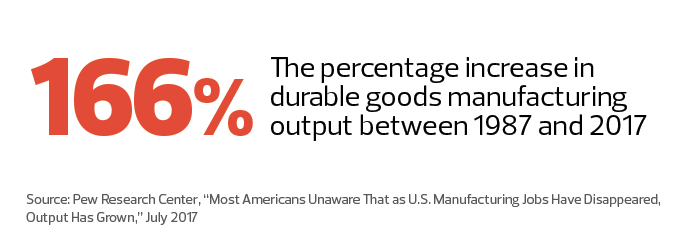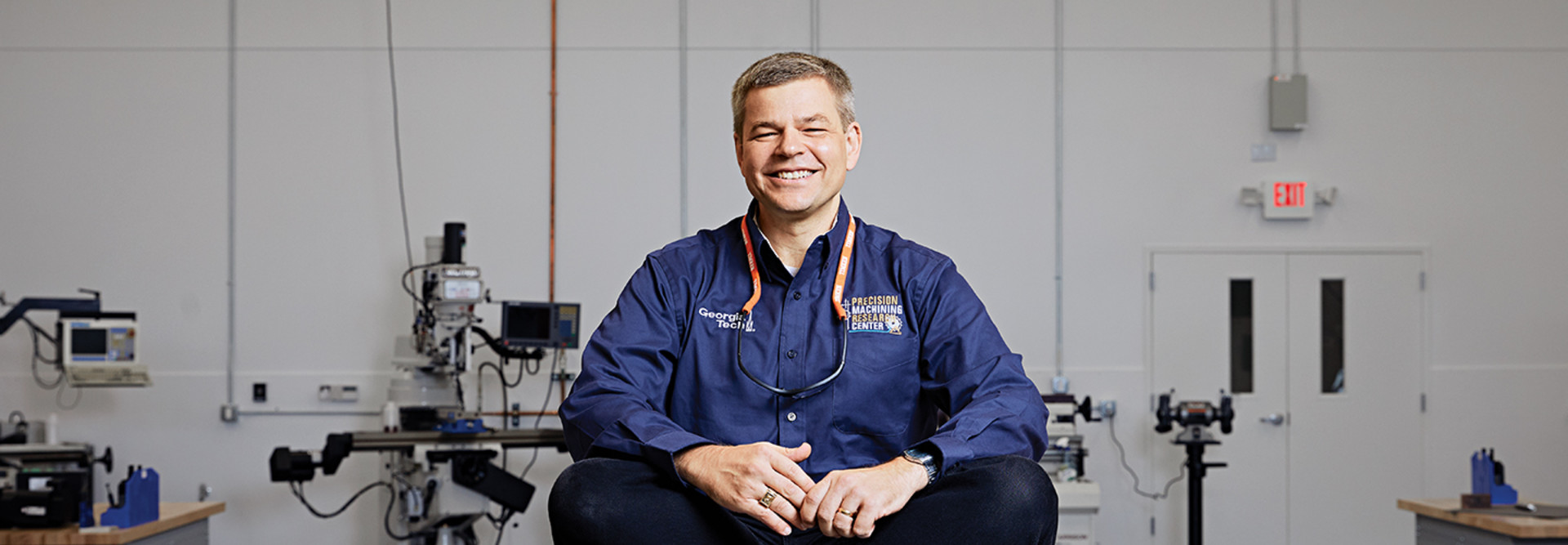High-Tech Manufacturing Programs Foster the Next Generation of Workers
When the Advanced Manufacturing Pilot Facility opened its doors at the Georgia Institute of Technology in July, it was an apt marriage of new and old. Built in partnership with Delta Air Lines, the state-of-the-art R&D facility sits on the former site of a decommissioned Atlantic Steel plant. Located on the north end of Georgia Tech’s campus and operated by the Georgia Tech Manufacturing Institute (GTMI), the manufacturing pilot is a public-private partnership where industry and academia collaborate to address technological challenges in advanced manufacturing and teach 21st-century skills.
Manufacturing has come a long way since the first assembly lines. But most undergrads have had little exposure to that world, says Thomas Kurfess, a professor of mechanical engineering who heads up digital operations for the institute.
“When I first ask my students what they know about manufacturing, they answer, ‘Henry Ford,’ ” Kurfess says. “They think it’s dirty and nasty, but if you go to a modern manufacturing facility today, it’s really clean and high-tech. It’s one of those things where you need to keep up with your training, because you’re using computers heavily.”
SIGN UP: Get more news from the EdTech newsletter in your inbox every two weeks!
Georgia Tech Manufacturing Facilities Mimic the Real World
GTMI is one of dozens of advanced manufacturing facilities on campuses nationwide, all aiming to train students and give industry access to cutting-edge research.
At Georgia Tech, interns learn advanced skills in computer numerical control machining, computer-aided design and computer-aided manufacturing, 3D printing and other modern manufacturing technologies.
The university’s Manufacturing Scholars Program pairs undergrads with a professor-mentor and an industry partner to solve specific problems, Associate Director Tina Guldberg says. For example, last year a student worked with aircraft manufacturer Sikorsky to develop an image processing technology to inspect helicopter parts.
The year-long program, which includes a three-month internship at a company, benefits businesses and students in equal measure, Guldberg says: “It gives students the opportunity to gain real-world experience, while giving industry an opportunity to get to know students they might want to hire long-term. It’s a real win-win.”
The technology behind the center is somewhat similar to other systems on the Georgia Tech campus, says Andrew Dugenske, GTMI’s factory information systems director. But there are important differences; for example, the manufacturing environment is more rugged.
“When you’re dealing with big things that can move around and crush networking gear, you need it to be a little more hardened,” he says. “But the biggest challenge is getting different devices to communicate. There are so many different protocols and standards that getting them to interoperate is tough.”

For businesses, centers like GTMI provide an ideal test environment: mimicking conditions on their own shop floors while allowing for experimentation, says James Woodell, vice president for economic development and community engagement at the Association of Public and Land Grant Universities.
“It’s also hugely beneficial for students who are learning about applied technology to experience the work environment around that technology,” he says. “You want people to be able to learn in a safe environment.”
But the biggest benefit, Woodell says, may be the partnerships that emerge. “Not only do these facilities provide great environments for research and learning, they also provide great environments for universities and their industry partners to collaborate, strategize and solve problems,” he says.
Greenville Tech Innovators Solve Real Problems
Greenville, S.C. — home to GE Power Systems, Michelin’s North American headquarters and the world’s largest BMW plant — is no stranger to modern manufacturing. That’s a key reason Greenville Technical College opened the $25 million Gene Haas Center for Manufacturing Innovation a year ago.
“We wanted to bring a 21st-century vision of what manufacturing is to young people and their parents,” says CMI Executive Director David Clayton. “It’s not a dusty, dangerous place. It’s floors that shine, machines that are computer- controlled. It’s a place where you’re using your mind as much as your hands.”
Just over 400 of Greenville Tech’s 12,000 students take part in the manufacturing program, with about half onsite and the rest at five satellite campuses, Clayton says.
GTC is also partnering with Clemson University on a Manufacturing Honors College, pairing undergrads with Clemson graduate engineering students to solve real-world manufacturing problems.
The CMI uses the same networking gear that’s used across campus: Avaya routers and switches, NetApp storage devices and HPE servers running VMware ESXi, says Tim Tennis, IT infrastructure support services manager. In addition, the center has four computer labs with HP Elite Mini 800 desktop PCs, plus another two Mini 800s mounted on mobile carts to control the robotic arms used on the manufacturing floor.
Outfitting the CMI was a lot like outfitting a classroom or office, Tennis says, except for scale — that is, having to spread wireless signals across a large room with high ceilings and lots of large, metal objects.
“We had to do more tuning and planning of Wi-Fi coverage than we might normally do,” he says. “And because the ceilings are so high, getting physical wire to a piece of equipment was a bit more challenging.”
Given the rapid pace of technological change, programs like these are becoming essential for anyone who hopes to work in modern manufacturing, says Clayton. “Our goal is to teach students the things they need to know now, and give them a taste of what they’ll need to know in five or 10 years,” he says. “More important, we’re teaching them how to be problem solvers and team players in a professional work environment.”
Simulation Prepares University of Maine Graduates for Careers
When Hussey Seating, a North Berwick, Maine, manufacturer of stadium equipment, wanted to investigate new technology applications for bleacher design, it turned to the nearby Advanced Manufacturing Center at the University of Maine.
“They actually built a whole bleacher section here in our lab,” AMC Director John Belding says. “We prototyped and tested various designs to assess feasibility. The student leading that project ended up going to work for them as a design engineer.” Each year, 15 to 20 electrical and mechanical engineering students work at AMC under the supervision of a staff member, collecting a paycheck that’s slightly better than minimum wage.
“I always tell the students that they won’t make a lot working here, but when they graduate and get their first job, they’ll see a big difference in their starting salary,” Belding says.

Like other university manufacturing facilities, the AMC relies on campus network and IT services. But having been designed from the ground up to accommodate manufacturing, AMC runs into very few infrastructure problems, Belding says.
“We have antennas all over our large, high bay area so we can get very strong Wi-Fi throughout the whole building,” he says. “One thing we need to do is move up to a 100-gigabit network, mostly due to moving large CAD files. When you’re working collaboratively, you need very high bandwidth between all the computers.”
As factories get more automated and companies adopt a design it/build it paradigm, engineers and factory workers need hands-on experience you can’t get from books, Belding says: “The days when a company can just hire someone off the street to sit there and push buttons on a CNC machine are numbered. Those need to be, at minimum, graduates of two-year tech schools, but a lot of companies are hiring engineers to do that now.”









